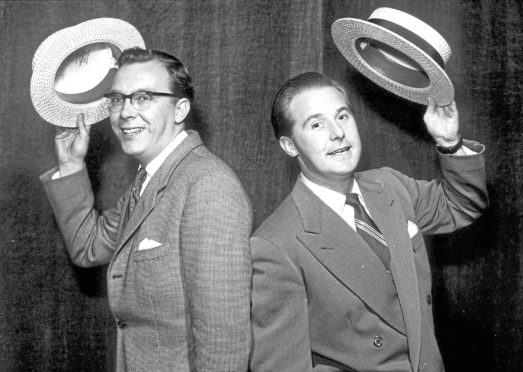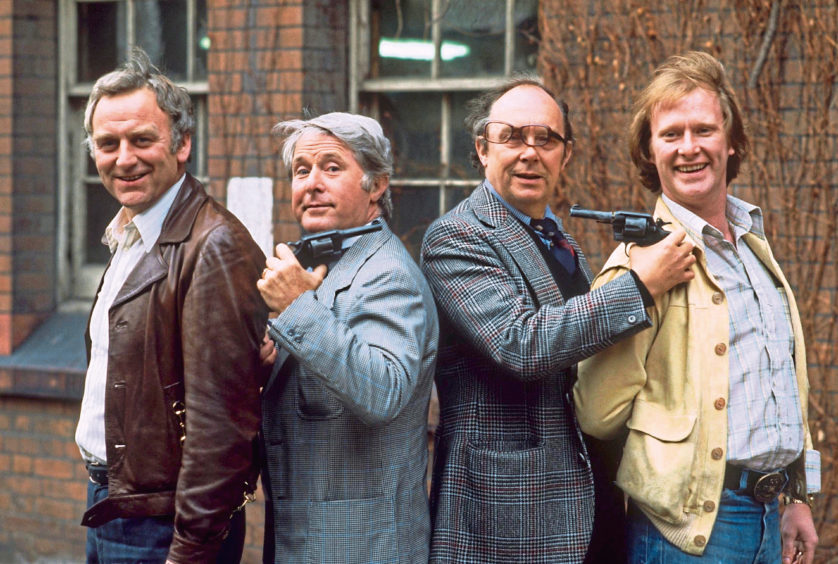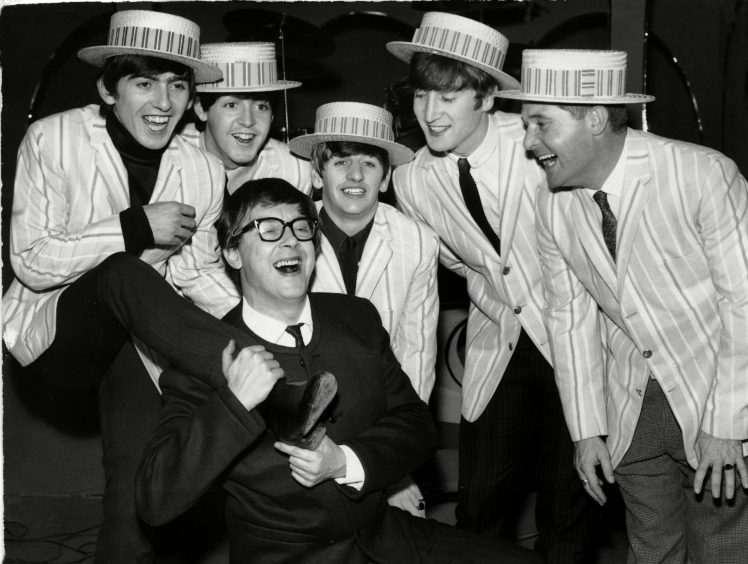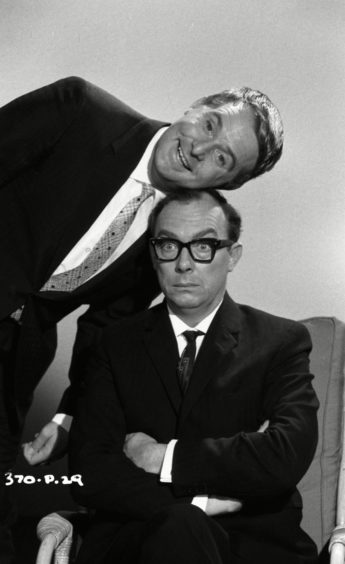
Two of a kind. They sang together, danced together, worked together and performed brilliantly together.
Eric and Ernie are still sadly missed and just the mention of them brings a smile to our faces.
Eric made us laugh the most, but perhaps the real strength of the duo was Ernie Wise – was he really the man behind Eric Morecambe?
“It was a partnership,” Ernie insisted whenever he was asked about their relationship. “We didn’t always agree, but we were good friends, close friends, and we knew each other well enough to be able to quickly sort any differences.”
Life was never the same for Ernie after Eric died although he kept working and his obvious talent shone through as an individual.
“When Eric went it was what I imagine an amputation to be like,” he once told me. “There were many things that we both did automatically and then I found that I couldn’t. If I’d had my right arm removed it would have been very strange to write with and pick things up with the other. That’s what it has been like to lose Eric.”
But what if there had been no Morecambe and Wise? Would there still have been an Ernie topping the bill and winning countless awards?
Ernest Wiseman was a Yorkshireman, born at Ardsley, close to Leeds, on November 27 1925. He was one of five children with a dad named Harry and a mum called Connie. They were ordinary working-class people.
“My dad worked on the railways as a porter and my mum was a weaver,” Ernie recalled. “How they met was a bit odd because my father actually tripped over my mother’s umbrella and that was how they come to speak to each other, get to know each other and eventually get married. You could say that I am here because of an umbrella.
“My mother was a brilliant housekeeper. We didn’t have much money, but she managed well and she was always full of life and very positive.
“My dad was a very loving, very generous man and in part the reason we didn’t have very much was because he was always helping people out. It made life tough and I have never forgotten what it was like to having nothing.
“One thing we always had though was music. My mother had saved up and bought a piano before she was married and it was there all the time. She played it marvellously whether she was just playing a piece of music or we were having a singalong.
“She was proud of having saved up for that piano and always reminded us of the value of being wise with your money by spending what you needed to spend, treat yourself a little, but make sure you saved some. I never forgot that advice. Money was often a joke between Eric and myself, but there was a serious side to it, too.”
So, it was his mother who inspired little Ern to take to the stage? Not entirely. His father was also a key player because Harry used to do a song and dance act around the local working men’s clubs for a few extra shillings.
“It was my mother who taught me about music and singing, but it was my father who taught me to dance in different styles and to perform to an audience,” said Ernie.
“When I was around seven he had taught me enough for me to appear alongside him in an act he called Carson and Son. I loved it right from the start and that was really the beginning of my career.”
Could there have been a better education? Carson and Son became very popular and the bookings became more frequent and farther away so that Ernie’s schooling was affected and Harry became a target for the authorities.
“He kept us going though and the extra money was really useful to the household,” said Ernie. “In fact, we were doing so well that I don’t think my dad could afford to stop even if he wanted to obey the authorities. As for me, I was learning all the time and I knew what I wanted to do for the rest of my life.”
There were a number of talent shows touring the country at the time, among them one organised by the great impresario of the day, Jack Hylton.
Ernie’s father encouraged him to take part in these shows in a solo act and helped him to hone his performance. Ernie was successful and won a few quid. The disappointment was The Jack Hylton Show as all he received was a “well done, we’ll let you know” kind of response.
Several months later, though, a letter arrived from the Jack Hylton office and Ernie was invited to go to London for an audition. It was a day Ernie never forgot.
“It was Friday January 7 1939,” Ernie remembered. “I hadn’t long turned 13 and my dad travelled to London with me for the audition. I think he was more nervous than I was.
“I did my audition on the Friday afternoon and to my surprise I was asked to appear that same evening in a show called Band Waggon which starred Arthur Askey. It was at the Princess Theatre. I went on and did my stuff and hoped that I was OK.
“The next day I was in the newspapers with headlines saying that I had stolen the show. I was amazed and delighted but, to be honest, how could anyone steal a show from the great and lovely Arthur Askey?
“I think my dad was thrilled, proud but upset all at the same time because I was offered a contract and he knew that our act together was over. I stayed in London with a chaperone and he went home. I felt that I wanted to go with him, but he assured me that I had to take advantage of what had happened. I think I grew up quite a lot at that point.”
The show ran in London for several months and then Jack Hylton took his band and show on tour and Ernie was included. Along the way, Jack continued to look for talent and one day Ernie watched an audition in which another young man sang a little, joked a little and then did an Al Jolson impersonation. He was impressive. Ernie met Eric Bartholemew for the first time.
“I was worried because I thought he might be hired instead of me, but it didn’t quite work out like that,” Ernie remembered. “We got on well and kept in touch. Then the war came along and Eric went down the mines while I was invited to go and live with Jack Hylton and his family on the Sussex coast.
“It was really nice and I got pocket money even though we weren’t working. Then I realised that if I wasn’t doing anything in particular I should be doing it with my family back in Leeds, so I went.
“There wasn’t much for me to do there either. I did a few local clubs and worked on delivering coal for a while. Then, as time went by, I was invited to join a show called Youth Takes A Bow.
“I was to go to Swansea and then we would tour. I would get seven pounds a week, which was pretty good. When I got there Eric Bartholomew was also there and joined the show. It was not long before we were working on a double act and that was how Morecambe and Wise began.”
We are all delighted Eric and Ernie got together and gave us not only laughter, but great memories. I once asked Ernie what might have happened if they had never met.
“I would have had a career in show business, I am sure of that,” Ernie said. “I was already in the early stages of my career and I was still learning. You never stop learning really. There are always new gags, new dance steps, new sketches.
“If you just do exactly the same thing time after time people lose interest. You always have a basic routine, but you continue to decorate it with new stuff and keep it fresh.
“I don’t know if I would ever have been a star act because usually you have to be a stand-up comedian or a very popular singer. I was an all-rounder, a song-and-dance man with a few gags who would always get work and maybe make it as a special guest star, but top-of-the-bill is a different sort of artist.”
After Eric died in 1984, Ernie was in demand for chat shows and guest appearances, but the top-of-the-bill days were virtually over. He was excited when asked to appear in the West End in a production of Dickens’ The Mystery Of Edwin Drood.
“It’s a marvellous play because the audience got to choose the ending, so it is quite a challenge to be able to adapt to whatever is decided,” he said at the time. “It means that the ending could be one way at a matinee and another way in the evening. I play a music hall chairman, a great part and one I am very comfortable with.”
So life did indeed go on for Little Ern until his own death in 1995.
The man behind Eric Morecambe was how Ernie Wise was once described, but that didn’t bother Ernie at all.
“We were partners with Eric as the show and me as the business,” he said. “Eric got most of the laughs, but we shared the act equally. We were friends.”
Indeed they were. They were both talented entertainers and both would have had careers as solo entertainers. Put them together and they were a volcano of fun like no other.
They were equally Morecambe and Wise – two of a kind.

Enjoy the convenience of having The Sunday Post delivered as a digital ePaper straight to your smartphone, tablet or computer.
Subscribe for only £5.49 a month and enjoy all the benefits of the printed paper as a digital replica.
Subscribe © Chris Capstick/Shutterstock
© Chris Capstick/Shutterstock © Daily Sketch/Shutterstock
© Daily Sketch/Shutterstock © ITV/Shutterstock
© ITV/Shutterstock